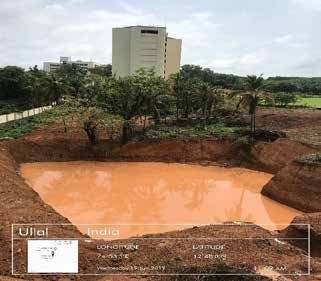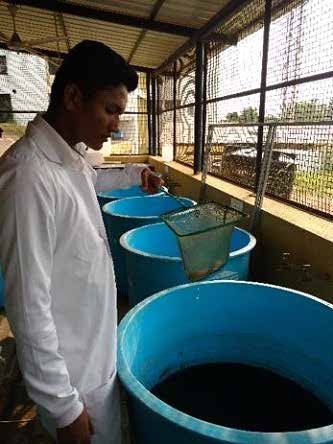
Life Below Water
Life below water refers to the living and non- living beings found in the water bodies creating a self-sustainable ecosystem. Water bodies form 97 percent of Earth’s water. Oceans cover three quarters of the Earth’s surface which represent 99 percent of the living space on the planet by volume. Marine fisheries employ over 200 million people. Water bodies have also been vital conduits for trade and transportation. Careful management of this essential global resource provides us a key feature for a sustainable future. We relish the fruit of goodness from the resources around us by continuously abusing them. Resources though vast, its depletion is just the beginning of exhaustion. Exhaustion of these resources is also the beginning of depletion of human health and jobs. The damage cannot be reversed but effort must be made to prevent further exploitation. Universities and Multinational Companies play a major role in bringing about changes and striking a difference, be it globally or locally.
NitteDU practices Use, Reuse, Reduce and Recycle of water on campus:
All students, employees and visitors to the constituent units, sections, and centres of Nitte DU have free access to clean drinking water. Drinking water is available through UV based water purifier dispensers. The quality of water is assessed periodically through both in-house and external testing. The quality of the various water sources including drinking water available in the University campus is periodically sampled and tested for various chemical and microbial parameters. This contributes to a healthy campus. All major buildings have separate storage facilities for potable and non-potable water. Segregated storage tanks and pipelines are available for potable water, stormwater and grey water.
Building practices for water conservation:
NitteDU consciously incorporates water conservation practices while designing and constructing buildings on its campus. Construction is compliant with National Building Code of India 2016 (NBC 2016). Standards IS1172 and IS2064 related to Water Supply, Drainage and Sanitation are adhered to. Water conservation guidelines from Environmental Guidelines for Buildings, Ministry of Environment, Forests & Climate Change, Government of India are also followed.
Sensitization and training about water conservation:
NitteDU undertakes sustained campaigns to encourage students and staff to save water within the campus. Modules on environmental sustainability, including water conservation, are included in the formal curriculum of most programs. The National Service Scheme volunteers conduct campaigns to raise awareness about water conservation.
WATER RECYCLING:

Use of recycled water for gardening and toilet flushing purposes. The wastewater is collected and treated in Sewage Treatment Plants (STP). Three campuses have individual STPs. The KSHEMA campus has a STP plant of handling capacity of 4,00,000 litres/day. University and Hospital campus have a plant of 8,00,000 litres/ day and Paneer campus has a plant handling 2,50,000 litres/day.
WATERSHED MANAGEMENT SYSTEMS:
The whole water supply network data is collected by GPS survey. The Nitte village has eighteen water sources with sixteen bore-wells and two water tanks to supply water to 12,000 populations. All of these sources are connected through branches of the network to supply drinking water to consumers. This was carried out through Network Mapping of Drinking Water Supply at Nitte Village Panchayath, Udupi using Global Positioning System (GPS). Further information of this project is available in this doi:10.13140/RG.2.2.20685.74725.
Paneer campus of Nitte DU has a storm water collection point. The water from the asphalted surface is collected in a pond. The water percolates to the ground, causing an increase in the level of water in surrounding borewells all round the year.


NITTEDU SELECTED BY DBT TO CONDUCT A NEW COURSE IN MARINE BIOTECHNOLOGY:
Nitte (Deemed to be University) introduced a new postgraduate programme, sponsored by the Department of Biotechnology, Government of India. In the year 2020, the Ministry of Science & Technology, Department of Biotechnology (DBT), Govt. of India has approved Nitte University Centre for Science Education & Research (NUCSER) to offer Master of Science in Marine Biotechnology. This recognition is awarded by the DBT that will sponsor ten students with a national fellowship. Students are selected through a National Level Graduate Aptitude Test-Biotechnology (GAT-B) for all Biotechnology- related courses in India. The goal of this programme is to provide appropriate laboratory and communication skills for the development of various technologies and implement the need of the economy through entrepreneurship, study the marine environmental systems and fisheries, support the industrial sector by promoting the relevant applications and development of marine biotechnological process, train and empower youth mind to develop the sustainable strategy of harnessing the marine environment for food, medicines and other resources.INTERNATIONAL COLLABORATION ON DISEASE PREVENTION IN AQUACULTURE:

The NitteDU in collaboration with scientists from the Norwegian University of Life Science, Oslo, has undertaken a research project that uses various biotechnological approaches to prevent and control fish disease in aquaculture (BIOAQUA). This venture has been financially supported by the Department of Science & Technology (DST), Government of India, with a budget of Rs. 45 lakhs. The aim is to promote scientific renewal and development of disciplines and/or to generate new knowledge about issues relevant to both societies in mutually agreed fields and to achieve bilateral world-class scientific results in the field of bioeconomy. Research on Defence genes of Tiger shrimps (Penaeus monodon) with respect to bacteria (Vibrio harveyi) and white spot syndrome virus (WSSV) infection is Bossier of Ghent University.

CENTRE OF INNOVATIVE SCIENCE AND ENGINEERING EDUCATION
Vision group of Karnataka IT & BT, Government of Karnataka has provided a grant amount of Rs. 25 lakhs to the centre for developing sustainable technologies for mitigating heavy metal pollution under changing environment under the Centres of Innovative Science & Engineering Education (CISEE) scheme to Prof. Dr. Smitha Hegde, NUCSER. Conventional techniques for removing heavy metals from industrial effluents include procedures like chemical precipitation, reduction, adsorption, ion exchange, evaporation and membrane processes. Often these involve use of additional undesirable chemicals. There is an urgent need to explore the possibilities of mitigating heavy metal pollution by eco-friendly, economically viable and sustainable methods. This centre at Nitte (Deemed to be University) will address and develop eco-friendly technologies and assist in mitigating heavy metal pollution in the SEZ zones of coastal Karnataka region of Dakshina Kannada. The centre is working towards knowledge generation and technology development along with generation of trained manpower to address environmental pollution issues.
RESEARCH PUBLICATIONS OF 2020:
- Dechamma, M.M., Mani, M.K., Rajeish, M.,Santhosh, K.S., Akhila, D.S., Maiti, B., Bossier,P., Karunasagar, I. and Karunasagar, I., 2020. Differential expression of akirin gene in black tiger shrimp Penaeus monodon in response to immunostimulant administration and infections with Vibrio harveyi and white spot syndrome virus. Journal of the World Aquaculture Society, 51(4), 1054-1065.
- Anupama, K.P., Nayak, A., Karunasagar, I. and Maiti, B., 2020. Rapid visual detection of Vibrio parahaemolyticus in seafood samples by loop-mediated isothermal amplification with hydroxynaphthol blue dye. World Journal of Microbiology and Biotechnology, 36, 1-10.
- Maiti, B., Dubey, S., Munang’andu, H.M., Karunasagar, I., Karunasagar, I. and Evensen, Ø., 2020. Application of outer membrane protein-based vaccines against major bacterial fish pathogens in India. Frontiers in Immunology, 11, 1362.
- Haenen, O., Karunasagar, I., Manfrin, A., Zrncic, S., Lavilla-Pitogo, C., Lawrence, M., Hanson, L., Subasinghe, R., Bondad-Reantaso, M.G. and Karunasagar, I., 2020. Contact-Zoonotic Bacteria of Warmwater Ornamental and Cultured Fish. Asian Fisheries Science, 33(S1), 39-45.
- Karunasagar, I., Karunasagar, I. and BondadReantaso, M.G., 2020. Complexities Involved in Source Attribution of Antimicrobial Resistance Genes Found in Aquaculture Products. Asian Fisheries Science, 33(S1), 16- 21.
- Kumar, S.N., Rai, P., Karunasagar, I. and Karunasagar, I., 2020. Genomic and antibody-based assays for the detection of Indian strains of Macrobrachium rosenbergii nodavirus and extra small virus associated with white tail disease of Macrobrachium rosenbergii. VirusDisease, 31(4), 459-469. • D’Souza, C., Prithvisagar, K.S., Deekshit, V.K., Karunasagar, I., Karunasagar, I. and Kumar, B.K., 2020. Exploring the Pathogenic Potential of Vibrio vulnificus Isolated from Seafood Harvested along the Mangaluru Coast, India. Microorganisms, 8(7), 999.
- Kotian, A., Aditya, V., Jazeela, K., Karunasagar, I., Karunasagar, I. and Deekshit, V.K., 2020. Effect of bile on growth and biofilm formation of non-typhoidal Salmonella serovars isolated from seafood and poultry. Research in microbiology, 171(5-6), 165-173.
- Jazeela, K., Chakraborty, A., Rai, P., Kumar, B.K., Srikumar, S., van Nguyen, S., Hurley, D., Fanning, S., Karunasagar, I. and Deekshit, V.K., 2020. Draft genome sequences of Salmonella oslo isolated from seafood and its laboratory generated auxotrophic mutant. Journal of genomics, 8, 7.
- Prabhu, S.G., Srinikethan, G. and Hegde, S. 2020. Pelletization of pristine Pteris vittata L. pinnae powder and its application as a biosorbent of Cd(II) and Cr(VI). SN Applied Science, 2, 132. • Thekkeveedu, R. P., and Hegde, S. 2020. In vitrospore germination and phytoremediation of Hg and Pb using gametophytes of Pityrogramma calomelanos. International Journal of Phytoremediation, 23, 3, 307-315./li>

RESEARCH PROJECTS:
Genome sequences of seafood organisms have been explored through research. The researchers of Nitte (Deemed to be University) have genome sequenced Non-typhoidal Salmonella oslo, a seafood pathogen isolated from squid. Two isolates of S.oslo have been submitted to GenBank under the accession nos. of Z_ SJXK00000000 and NZ_SMLR00000000. Marine mangrove consists of priceless natural resources housing immense biosynthetic potential which is effective from a biotechnological and industrial point of view. The ecosystem harbours many rare bacteria with interesting physiological properties. It is suggested that these unique bacterial strains can be further studied in search for some broad-spectrum, novel antibiotics, which could be effective in the treatment of nosocomial infections. Thus, the institute has involved carrying out investigation for bioprospecting in the bacteria to tap and conserve the microbial resources of this important biodiversity and utilize their potential for human welfare. Microplastics are a source of concern in the aquatic environment due to its persistence and potential adverse effects on biota. Human pathogenic bacteria released from point (wastewater treatment plants) and diffuse sources (agricultural land) frequently contaminate water bodies downstream and therefore represent a potential risk to human health. A large proportion of these pathogenic organisms present in water become associated with various substrates representing a significant mechanism for delivering pathogens to coastal waters. Due to the growing concerns about microplastics and their influence on human health and the environment, studies were conducted by research group of Nitte Deemed to be University to check the ability of microplastics to act as a substrate for the biofilm formation by pathogenic enteric bacteria as well as their role in the transport of antimicrobial resistance. Further, studies on microplastics are undertaken at NUCSER to examine its presence in the seafood together with its ability to transfer at trophic levels.


.png)